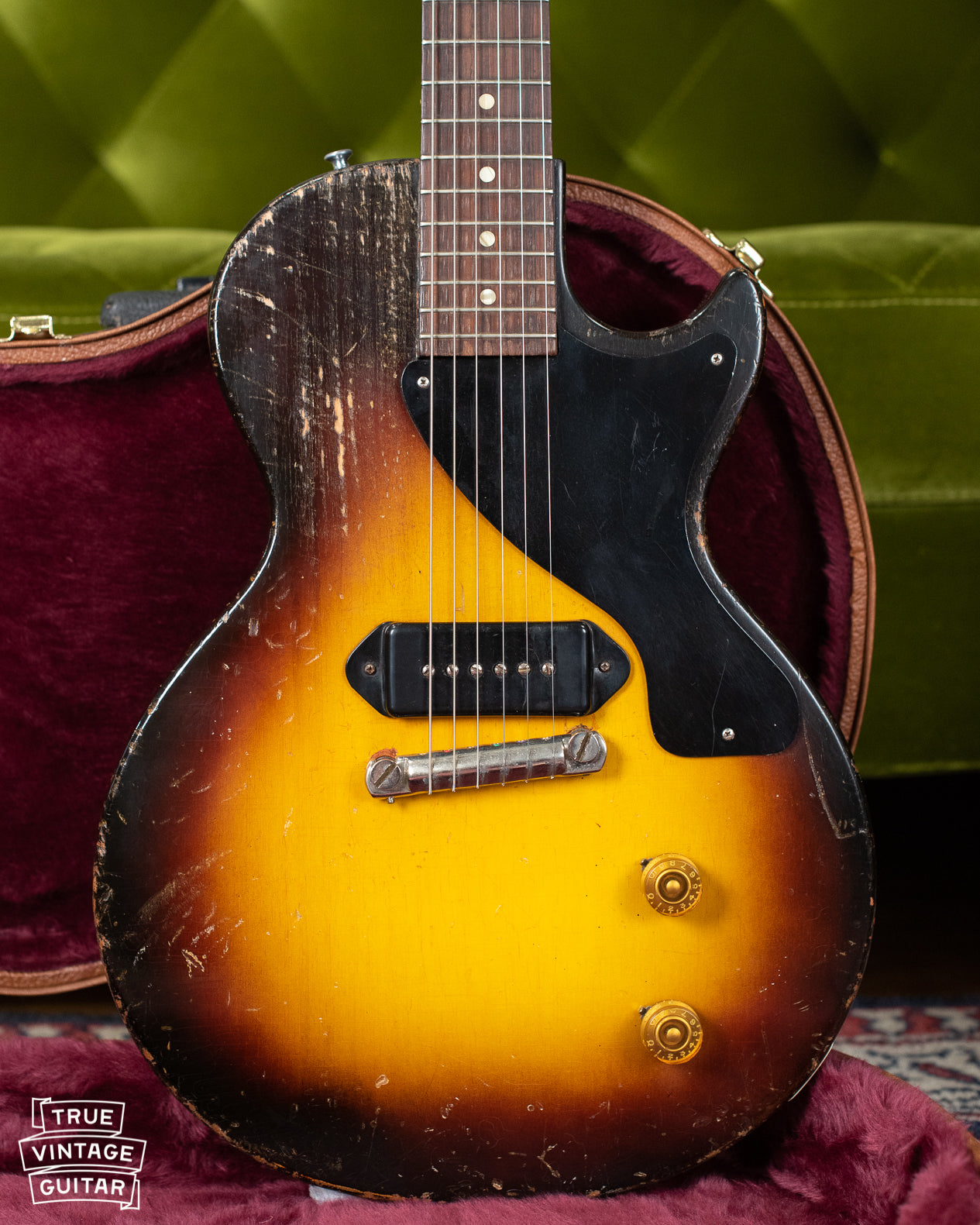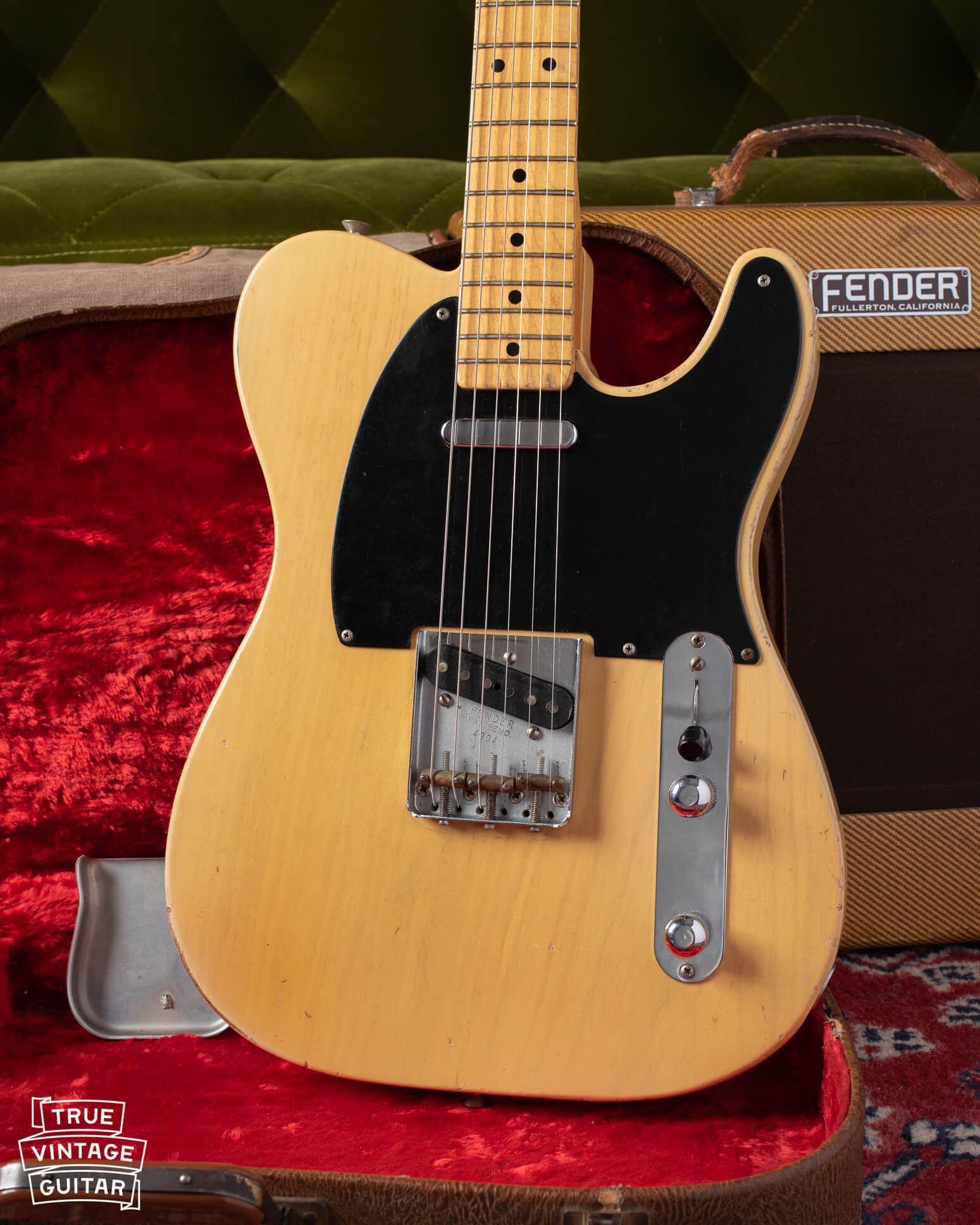Gibson is consistent in only one thing: inconsistency. As a result it can be very difficult to date some vintage Gibsons. When I say Gibson here, I mean Kalamazoo era Gibson (up until about 1977 give or take). Dating vintage Gibsons is sometimes an art rather than a science. Take for instance this guitar from the Music City Pickers out of Nashville, TN. I have met these guys and they are top notch. They always have great guitars coming and going and it is a joy to see. That being said, this one may deserve a second opinion: "1961 ES-125" at Music City Pickers.
 This is what the headstock should look like. See the sides how they are bent in? See the block logo?
This is what the headstock should look like. See the sides how they are bent in? See the block logo?
 This picture shows the top of the instrument. See those vertical lines? Classic evidence of a carved Spruce top. So what did ES-125s have?
Here is the best shot I can come up with. ES-125s all had laminated Maple tops. This is cheaper to make. Why would you make a student model guitar out of expensive solid Spruce? Also, electric guitars with solid Spruce tops tend to feed back more. This guitar does not show nice straight vertical lines. That is because it is an ES-125 and they are made of Maple- not Spruce.
This picture shows the top of the instrument. See those vertical lines? Classic evidence of a carved Spruce top. So what did ES-125s have?
Here is the best shot I can come up with. ES-125s all had laminated Maple tops. This is cheaper to make. Why would you make a student model guitar out of expensive solid Spruce? Also, electric guitars with solid Spruce tops tend to feed back more. This guitar does not show nice straight vertical lines. That is because it is an ES-125 and they are made of Maple- not Spruce.
We know the neck is not from 1961. It looks bad for the body to be for an ES-125. The Pickers said that they think that it was original and from the factory in 1961 because the body and the neck both have the same serial number. Here is a shot of that serial number:
 |
| Silver covered P-90s? |
 |
| Straight sides, script logo |
Why is this not an ES-125?? We know that this is at least something odd right off the bat because of the combination of the headstock and the P-90s. The headstock pictured has straight sides and a pearl script logo (as opposed to block logo- see picture below). This headstock was discontinued in 1941 and was never used again in the Kalamazoo factory. As per the write up on their website, it also have a V shaped neck. This was not popular in the 60s. The P-90 pickups it has were not produced until 1946. The math does't add up.
 This is what the headstock should look like. See the sides how they are bent in? See the block logo?
This is what the headstock should look like. See the sides how they are bent in? See the block logo?Gibson is known for inconsistency so why couldn't this have been a old neck laying around that was put on a 125 body? It could have been, but I doubt it. Here is why.
 This picture shows the top of the instrument. See those vertical lines? Classic evidence of a carved Spruce top. So what did ES-125s have?
This picture shows the top of the instrument. See those vertical lines? Classic evidence of a carved Spruce top. So what did ES-125s have?We know the neck is not from 1961. It looks bad for the body to be for an ES-125. The Pickers said that they think that it was original and from the factory in 1961 because the body and the neck both have the same serial number. Here is a shot of that serial number:
The number is "613." This one is very strange and also not correct for 1961. It needs at least one more digit to be in the ballpark.
This picture gives us another piece of evidence- the Grover Sta-Tite tuners. These were used in the 30s but not in the 60s. If a random neck was found in the factory left over from the 30s it would not have had tuners. It would have been unfinished. Therefore probably no tuners.
So what is this thing?
In my opinion, this guitar was produced in the mid to late 30s by Gibson in their Kalamazoo, MI. factory. By the time the 60s came around this was just an old guitar. There was no real value to "vintage" guitars. Few people cared about vintage. The first vintage guitar stores started in the late 70s (Gruhn). After 30 years of playing this thing looked kind of rough compared to the shiny new electrics that Gibson was producing. The owner sent the guitar back to the factory where the finish was stripped, body was drilled for modern electronics then a new finish was applied. The electronics were reinstalled and the guitar was sent back to its owner.
We can even make a good guess as to when the guitar was rebuilt/refinished. The Picker's advertisement for this guitar says that the potentiometers date to 1967. And the truth shall set you free! In my opinion, this is a mid to late thirties Gibson acoustic archtop that was sent back to the factory in 1967/8 and refinished/fitted with modern electronics.
But- Joe Glaser (Glaser Instruments), Todd Money (Gibson repair) and Gibson Customer Service all agree that this is a 1961! Joe Glaser is unrivaled in what he does- repair. Todd Money is right up there with Joe (in repair). Gibson Customer Service is well, they try. My point is that these guys are great but why should they be experts in dating Gibsons? Why should they care about someone else's guitar when they have thousands of others they need to attend to?
Dating vintage Gibson guitars is often an art. It is open for discussion. There are things in this article that are potentially incorrect. I welcome your opinions.
TVG





